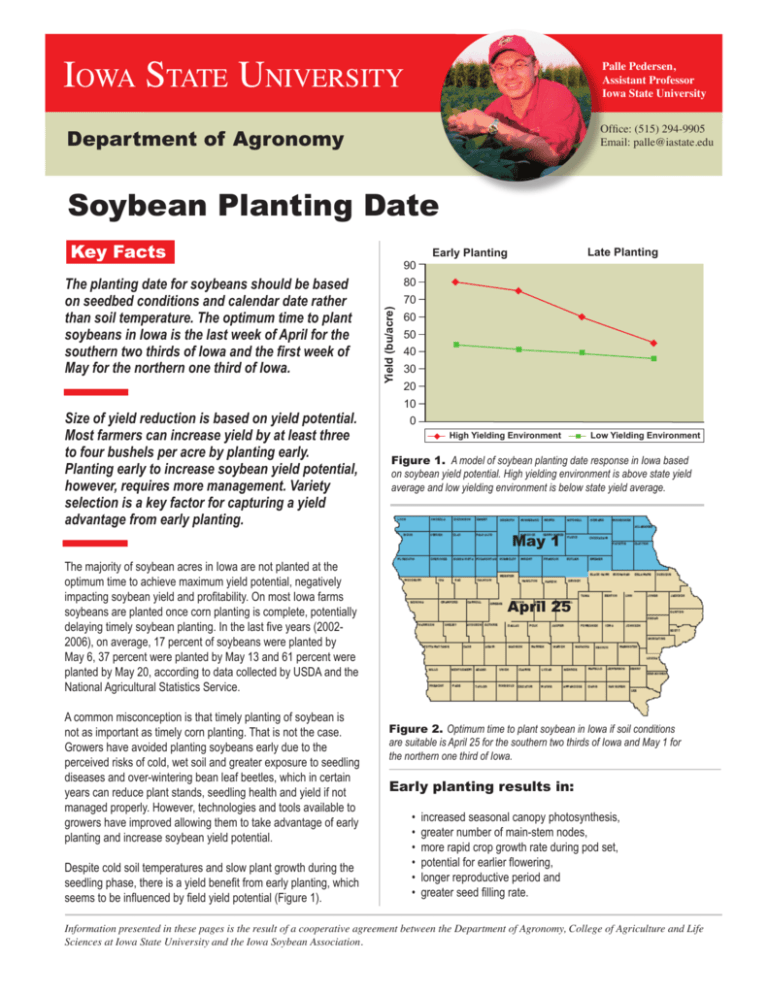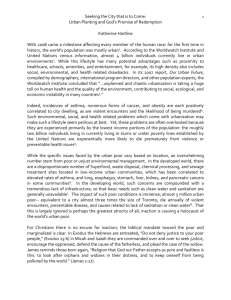Soybean Planting Date - Agronomy Extension
advertisement

Iowa State University Palle Pedersen, Assistant Professor Iowa State University Office: (515) 294-9905 Email: palle@iastate.edu Department of Agronomy Soybean Planting Date Key Facts Size of yield reduction is based on yield potential. Most farmers can increase yield by at least three to four bushels per acre by planting early. Planting early to increase soybean yield potential, however, requires more management. Variety selection is a key factor for capturing a yield advantage from early planting. Late Planting Early Planting 80 Yield (bu/acre) The planting date for soybeans should be based on seedbed conditions and calendar date rather than soil temperature. The optimum time to plant soybeans in Iowa is the last week of April for the southern two thirds of Iowa and the first week of May for the northern one third of Iowa. 90 70 60 50 40 30 20 10 0 High Yielding Environment Low Yielding Environment Figure 1. A model of soybean planting date response in Iowa based on soybean yield potential. High yielding environment is above state yield average and low yielding environment is below state yield average. May 1 The majority of soybean acres in Iowa are not planted at the optimum time to achieve maximum yield potential, negatively impacting soybean yield and profitability. On most Iowa farms soybeans are planted once corn planting is complete, potentially delaying timely soybean planting. In the last five years (20022006), on average, 17 percent of soybeans were planted by May 6, 37 percent were planted by May 13 and 61 percent were planted by May 20, according to data collected by USDA and the National Agricultural Statistics Service. A common misconception is that timely planting of soybean is not as important as timely corn planting. That is not the case. Growers have avoided planting soybeans early due to the perceived risks of cold, wet soil and greater exposure to seedling diseases and over-wintering bean leaf beetles, which in certain years can reduce plant stands, seedling health and yield if not managed properly. However, technologies and tools available to growers have improved allowing them to take advantage of early planting and increase soybean yield potential. Despite cold soil temperatures and slow plant growth during the seedling phase, there is a yield benefit from early planting, which seems to be influenced by field yield potential (Figure 1). April 25 Figure 2. Optimum time to plant soybean in Iowa if soil conditions are suitable is April 25 for the southern two thirds of Iowa and May 1 for the northern one third of Iowa. Early planting results in: • • • • • • increased seasonal canopy photosynthesis, greater number of main-stem nodes, more rapid crop growth rate during pod set, potential for earlier flowering, longer reproductive period and greater seed filling rate. Information presented in these pages is the result of a cooperative agreement between the Department of Agronomy, College of Agriculture and Life Sciences at Iowa State University and the Iowa Soybean Association. Soil conditions at and following planting are the primary drivers for planting and stand establishment. Planting into a wet seedbed or a hard rain following planting will result in crusting and reduced plant stands. The ideal soil temperature for rapid soybean germination and emergence is between 77 to 86ºF. Soil temperatures at a 4-inch depth in Iowa do not reach these levels until mid- to late-June. However, soybean will begin to germinate at soil temperatures around 50ºF, around mid- to late-April. At this temperature it is not unusual that two to three weeks will separate planting and plant emergence. Numerous factors influence the decision on when to plant soybeans. If soil conditions are suitable, soybean should be planted during the last week of April and the first week of May in Iowa. Planting depth should be 1 to 1.5 inches and not deeper than 2 inches. Planting soybean early is not advisable until you have good seedbed conditions. “Mudding-in” soybean just to plant early – causing soil compaction and poor seed placement – outweighs any benefit of early planting. An extensive research project was initiated in 2003 across Iowa to assess the impact of planting date on soybean yield. Based on 24 experiments across Iowa since 2003, there is a 79 percent probability of achieving a higher yield by planting the last week of April (southern two thirds of Iowa) or the first week of May (northern one third of Iowa) compared with approximately May 20. Summary There is risk associated with early planting, and this risk should be evaluated prior to planting. It takes more management to increase yield potential when planting early. However, the strong yield advantages should outweigh those risks as long as planting recommendations are followed. The optimum time to plant soybeans in Iowa is the last week of April for the southern two thirds of Iowa and the first week of May for the northern one third of Iowa if soil conditions are suitable. Table 1. Benefits and risks of planting soybeans early in Iowa. Benefits Higher yield and profitability Shorter plants and less lodging Earlier flowering More vegetative nodes Potential for earlier harvest Risks Crusting Damping off Late spring frost Bean leaf beetles Sudden death syndrome Planting earlier than this will increase the likelihood of having to replant fields that may be severely damaged by frost and/or lethally cold temperatures. Early planting, in addition to delayed seedling emergence, may increase imbibitional injury and exposure to late-spring frost. However, if the above recommendations are followed the chances for imbibitional injury and an exposure to late-spring frost are minimized. Migration of over-wintering bean leaf beetles to first-emerged soybean fields in spring causes leaf defoliation, stand loss and transmission of bean pod mottle virus, potentially limiting the benefit to early planting. Bean leaf beetles are mostly a problem in the southern half of Iowa and can be easily managed with an insecticide seed treatment or foliar application of an insecticide. Poorly-drained and compacted soils increase the potential of seedling diseases when planted into cool and wet soils. Pythium spp. is the most common seedling disease detected in roots followed by Rhizoctonia spp., and Phytophthora spp. Stand reduction can occur from these pathogens and the use of a fungicide seed treatment may be needed to protect the seed during stand establishment. Stand reduction can also occur from crusting, which is often associated with excessive tillage or a hard rain just after planting. Based on research in plots at Whiting, Nevada and De Witt from 2004-2006, it was concluded that variety selection was not influenced by planting date. A high-yielding variety will be high yielding no matter when it is planted. However, the yield penalty for selecting the wrong variety can be much greater when planted early. Soybean planting date has important implications not just for yield and profitability, but can also influence disease development. Sudden death syndrome is the most common disease associated with early planting in Iowa, but can be managed with variety selection. Figure 3. Early planted soybeans should be scouted frequently for bean leaf beetles. Bean leaf beetles were not managed in the plot to the left. For more information about soybean management go to www.soybeanmanagement.info. The U.S. Department of Agriculture (USDA) prohibits discrimination in all its programs and activities on the basis of race, color, national origin, gender, religion, age, disability, political beliefs, sexual orientation, and marital or family status. (Not all prohibited bases apply to all programs.) Many materials can be made available in alternative formats for ADA clients. To file a complaint of discrimination, write USDA, Office of Civil Rights, Room 326-W, Whitten Building, 14th and Independence Avenue, SW, Washington, DC 20250-9410 or call 202-720-5964. Issued in furtherance of Cooperative Extension work, Acts of May 8 and June 30, 1914, in cooperation with the U.S. Department of Agriculture. Jack M. Payne, director, Cooperative Extension Service, Iowa State University of Science and Technology, Ames, Iowa. This publication and the research summarized therein were partially funded by the Iowa soybean checkoff.




